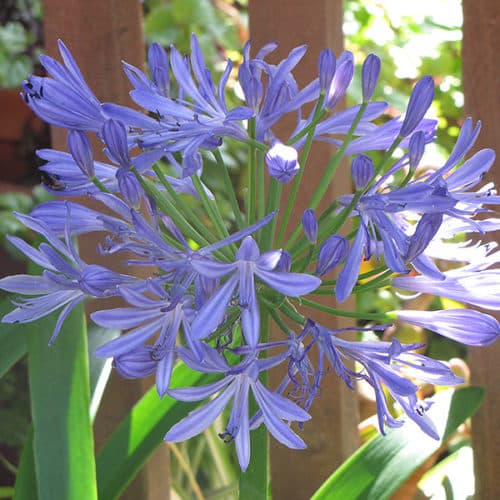Agapanthus Propagation: Tips for Expanding Your Plant Collection
Agapanthus Propagation: Tips for Expanding Your Plant Collection
Blog Article
Grasping the Art of Agapanthus Treatment: Vital Steps for Healthy Growth and Vibrant Blossoms
In the world of horticulture, the cultivation of agapanthus stands as a gratifying venture for those that seek to support these stylish flowering plants. With their striking blossoms and elegant vegetation, agapanthus has captured the interest of gardeners worldwide. However, attaining optimal development and lively blossoms requires a nuanced method that includes different essential actions. From picking the ideal range to grasping pruning strategies, the journey in the direction of cultivating thriving agapanthus plants is complex and holds the vital to opening the full possibility of these agricultural gems.

Selecting the Right Agapanthus Selection

When selecting the ideal Agapanthus range for your garden, think about factors such as climate viability, blossom color, and development behavior. Furthermore, think about the environment in your region to make sure the Agapanthus variety you choose can prosper in your certain problems. Understanding the growth behavior of different Agapanthus selections is essential for appropriate positioning within your garden.
Ideal Planting Problems
Taking into consideration the optimal environmental needs is essential for effective Agapanthus cultivation. Agapanthus prospers in well-draining dirt with a somewhat acidic to neutral pH degree. When growing, choose a place that receives complete sunlight to partial shade. In hotter environments, supplying some mid-day color can protect against scorching of the leaves. Agapanthus plants are sensitive to cool temperature levels and need to be protected from frost throughout winter months.
To make sure healthy and balanced development and dynamic flowers, plant Agapanthus bulbs at a deepness of concerning 2-4 inches and area them 8-12 inches apart. Including organic issue, such as compost, to the dirt can enhance water drainage and fertility, advertising durable origin advancement. Mulching around the base of the plants aids preserve wetness and reduces weed growth. Normal watering is important, particularly throughout the expanding period, to keep the soil consistently damp but not soaked.
Watering and Feeding Tips
Maintaining appropriate wetness levels and offering important nutrients are crucial aspects in the treatment program for Agapanthus plants. When it comes to sprinkling Agapanthus, it is crucial to strike an equilibrium. These plants like continually damp dirt however are vulnerable to root rot if overwatered.
Fertilizing Agapanthus is necessary for promoting healthy development and respected blossoms. Use a balanced plant food, such as a 10-10-10 formula, in the very early springtime as brand-new growth arises. By following these watering and fertilizing ideas, you can ensure your Agapanthus plants thrive and create view publisher site lively, long-lasting blossoms.
Trimming Methods for Agapanthus
Trimming Agapanthus plants at the ideal times and with appropriate methods is essential for preserving their wellness and promoting ideal development and flowering. The optimal time to trim Agapanthus is in late wintertime or early spring before brand-new growth arises.
Deadheading invested flowers can also redirect the plant's energy right into creating even more blooms instead than setting seeds. If you want to gather seeds for proliferation, leave some blossoms to fully grown and completely dry on the plant.
Remember to use tidy, sharp tools to make accurate cuts and lower the danger of presenting illness. Agapanthus. Normal trimming will certainly aid keep your Agapanthus looking cool and healthy while ensuring a plentiful screen of attractive blooms
Dealing With Usual Bugs and Diseases
After making sure correct trimming techniques for Agapanthus, it is vital to attend to common insects and conditions that can influence the health and wellness and vitality of these plants. One usual insect that influences Agapanthus is the Agapanthus gall midge.
Additionally, Agapanthus plants can experience from origin rot if they are grown in poorly draining pipes soil. By being watchful and taking punctual activity against click reference insects and illness, you can assist your Agapanthus plants grow and produce vivid blooms. Agapanthus.

Verdict
In verdict, grasping the art of agapanthus care entails selecting the right selection, supplying perfect growing conditions, correct watering and feeding, proper trimming strategies, and resolving common pests and diseases. By complying with these crucial steps, you can ensure healthy development and vibrant blooms for your agapanthus plants. Remember to frequently check and preserve your plants to promote their overall wellness and durability.
To guarantee healthy development and lively blossoms, plant Agapanthus light bulbs at a deepness of regarding 2-4 inches and room them 8-12 inches apart. By adhering to these watering and feeding suggestions, you can guarantee your Agapanthus plants grow and create lively, durable flowers.
One typical pest that impacts Agapanthus find out is the Agapanthus gall midge. In addition, Agapanthus plants can experience from root rot if they are grown in inadequately draining pipes soil. By complying with these vital steps, you can ensure healthy and balanced development and vivid flowers for your agapanthus plants.
Report this page